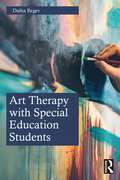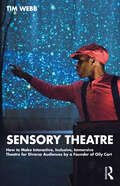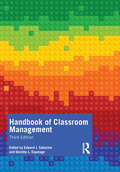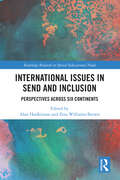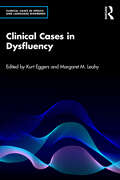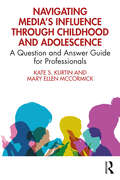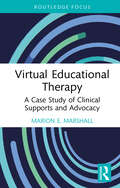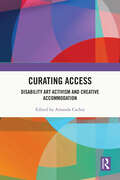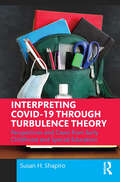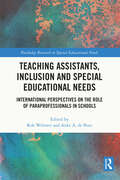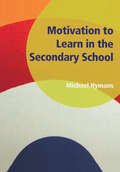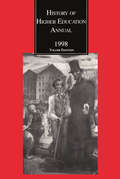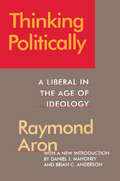- Table View
- List View
Art Therapy with Special Education Students
by Dafna RegevArt Therapy with Special Education Students is a practical and innovative book that details the best suitable ways to work in the field of art therapy with special education students. This book provides the reader with practical approaches, techniques, models, and methodologies in art therapy that focus on special education students, such as those with ASD, ADHD, learning disabilities, behavioral disorders, and students with visual and hearing impairments. Each chapter addresses a specific population, including an overview of the literature in the field, along with descriptions of practices derived from interviews with experienced art therapists who specialize in each population. The chapters cover the therapeutic goals of each population, the specific challenges, intervention techniques, and the meaning of art. Dedicated working models that have emerged in the field and collaborative interventions involving parents and staff members, along with clinical illustrations, are also available throughout the book. Art therapists and mental health professionals in the school system will appreciate this comprehensive collection of contemporary work in the field of art therapy with special education students.
Sensory Theatre: How to Make Interactive, Inclusive, Immersive Theatre for Diverse Audiences by a Founder of Oily Cart
by Tim WebbSensory Theatre: How to Make Interactive, Inclusive, Immersive Theatre for Diverse Audiences by a Founder of Oily Cart is an accessible step-by-step guide to creating theatre for inclusive audiences, such as young people on the autism spectrum or affected by other neuro-divergent conditions and children under two. Conventional theatre relies on seeing and hearing to involve its audience; sensory theatre harnesses the power of five or more senses to address its participants who have different ways of relating to the world around them. This book is an insightful history of Oily Cart and its pioneering development of work for the very young, including Baby Theatre, and for neuro-divergent audiences including those on the autism spectrum. It gives a clear introduction to the fundamental concepts of this theatre, suggests a host of practical techniques drawn from over forty years of experience, and describes some of Oily Cart’s most radical innovations, including theatre on trampolines, in hydrotherapy pools, and with flying audiences in the company of aerial artists. The book also includes copious photos from the Oily Cart’s archives and links to videos examples of the company’s work. Readers will learn how to: Research the intended audience while not being led astray by labels. Create a welcoming, immersive sensory space in classrooms, nurseries, school halls, and playgrounds. Devise sensory stories that can be adapted to suit different audiences. Recruit, audition, cast, and run rehearsals. Ensure that the production is truly sensory and interactive. Written for Theatre for Young Audiences, Drama in Education, and specialized Applied Theatre courses, as well as educators and theatre practitioners interested in creating inclusive, interactive productions, Sensory Theatre offers a goldmine of ideas for making work that connects with audiences who can be the hardest to reach.
Sensory Theatre: How to Make Interactive, Inclusive, Immersive Theatre for Diverse Audiences by a Founder of Oily Cart
by Tim WebbSensory Theatre: How to Make Interactive, Inclusive, Immersive Theatre for Diverse Audiences by a Founder of Oily Cart is an accessible step-by-step guide to creating theatre for inclusive audiences, such as young people on the autism spectrum or affected by other neuro-divergent conditions and children under two. Conventional theatre relies on seeing and hearing to involve its audience; sensory theatre harnesses the power of five or more senses to address its participants who have different ways of relating to the world around them. This book is an insightful history of Oily Cart and its pioneering development of work for the very young, including Baby Theatre, and for neuro-divergent audiences including those on the autism spectrum. It gives a clear introduction to the fundamental concepts of this theatre, suggests a host of practical techniques drawn from over forty years of experience, and describes some of Oily Cart’s most radical innovations, including theatre on trampolines, in hydrotherapy pools, and with flying audiences in the company of aerial artists. The book also includes copious photos from the Oily Cart’s archives and links to videos examples of the company’s work. Readers will learn how to: Research the intended audience while not being led astray by labels. Create a welcoming, immersive sensory space in classrooms, nurseries, school halls, and playgrounds. Devise sensory stories that can be adapted to suit different audiences. Recruit, audition, cast, and run rehearsals. Ensure that the production is truly sensory and interactive. Written for Theatre for Young Audiences, Drama in Education, and specialized Applied Theatre courses, as well as educators and theatre practitioners interested in creating inclusive, interactive productions, Sensory Theatre offers a goldmine of ideas for making work that connects with audiences who can be the hardest to reach.
Handbook of Classroom Management
by Edward J. Sabornie Dorothy L. EspelageThe Handbook of Classroom Management, Third Edition, is an authoritative treatment of the latest science and development in the study of classroom management in schools. Evidence-based classroom management practices and programs are essential to enhancing students’ academic, behavioral, social-emotional, and motivational outcomes across grade levels. This comprehensive volume collects scholarship and cutting-edge research for graduate students and faculty of psychology, teacher education, curriculum and instruction, special education, and beyond. The book has been thoroughly revised and expanded with updated coverage of foundational topics such as effective instruction, preventative strategies, positive behavior intervention and supports, family–school relationships, legal issues, and other related topics, while also giving new attention to social justice, students on the autism spectrum, and adaptations across urban, rural, and virtual contexts.
Handbook of Classroom Management
by Edward J. Sabornie Dorothy L. EspelageThe Handbook of Classroom Management, Third Edition, is an authoritative treatment of the latest science and development in the study of classroom management in schools. Evidence-based classroom management practices and programs are essential to enhancing students’ academic, behavioral, social-emotional, and motivational outcomes across grade levels. This comprehensive volume collects scholarship and cutting-edge research for graduate students and faculty of psychology, teacher education, curriculum and instruction, special education, and beyond. The book has been thoroughly revised and expanded with updated coverage of foundational topics such as effective instruction, preventative strategies, positive behavior intervention and supports, family–school relationships, legal issues, and other related topics, while also giving new attention to social justice, students on the autism spectrum, and adaptations across urban, rural, and virtual contexts.
International Issues in SEND and Inclusion: Perspectives Across Six Continents (Routledge Research in Special Educational Needs)
by Alan Hodkinson Zeta Williams-BrownInternational Issues in SEND and Inclusion brings together a collection of cutting-edge researches on approaches to special education needs and disability education, across 6 continents and within 12 countries. Written by authors who are experts in their own countries in relation to special educational needs and disability, the book provides a unique knowledge and understanding of different international perspectives in special educational needs, disability and inclusion. The chapters present extended case studies and reflect on current policy, practice and theory within that context, challenging assumptions which can dominate the policy and practice of inclusive education. Each of the six continents has a separate section and introduction within the book to offer a relevant approach and context for analysis. The book will be of great interest to academics, researchers and postgraduate students in the fields of inclusion, special educational needs and disability, teacher education and comparative education.
International Issues in SEND and Inclusion: Perspectives Across Six Continents (Routledge Research in Special Educational Needs)
by Alan Hodkinson Zeta Williams-BrownInternational Issues in SEND and Inclusion brings together a collection of cutting-edge researches on approaches to special education needs and disability education, across 6 continents and within 12 countries. Written by authors who are experts in their own countries in relation to special educational needs and disability, the book provides a unique knowledge and understanding of different international perspectives in special educational needs, disability and inclusion. The chapters present extended case studies and reflect on current policy, practice and theory within that context, challenging assumptions which can dominate the policy and practice of inclusive education. Each of the six continents has a separate section and introduction within the book to offer a relevant approach and context for analysis. The book will be of great interest to academics, researchers and postgraduate students in the fields of inclusion, special educational needs and disability, teacher education and comparative education.
Clinical Cases in Dysfluency (Clinical Cases in Speech and Language Disorders)
by Kurt Eggers Margaret M. LeahyClinical Cases in Dysfluency is an imperative work that introduces dysfluency in clinical and cultural contexts while encouraging reflection on clinical decision-making involving the assessment and management of clients. With inputs from eminent clinical researchers across the world, this text brings together diverse voices and expertise to provide readers with innovative ideas for their own practice. The book assists in refining clinical problem solving and valuing exchanges between clients and clinicians. Featuring real-life case studies covering stuttering and cluttering in children and adults, it showcases the importance of evidence-based practice and practitioner reflection, demonstrating a range of approaches to address problems experienced with dysfluency, and their management. The authors go on to discuss issues of stereotyping, resilience, and therapeutic commonalities in general, and in multicultural contexts, whilst also introducing the discipline of Dysfluency Studies, where stuttering is considered positively in its complexity and not as a disorder. These concepts are effectively further illustrated through accompanying online resources including videos, and weblinks. This is an indispensable resource for students and clinicians in the domains of Fluency, Speech and Language Pathology and Communication Disorders, and will be valuable reading to anyone interested in communication disorders, dysfluencies, and application of theory to practice in these disciplines.
Clinical Cases in Dysfluency (Clinical Cases in Speech and Language Disorders)
by Kurt Eggers Margaret M. LeahyClinical Cases in Dysfluency is an imperative work that introduces dysfluency in clinical and cultural contexts while encouraging reflection on clinical decision-making involving the assessment and management of clients. With inputs from eminent clinical researchers across the world, this text brings together diverse voices and expertise to provide readers with innovative ideas for their own practice. The book assists in refining clinical problem solving and valuing exchanges between clients and clinicians. Featuring real-life case studies covering stuttering and cluttering in children and adults, it showcases the importance of evidence-based practice and practitioner reflection, demonstrating a range of approaches to address problems experienced with dysfluency, and their management. The authors go on to discuss issues of stereotyping, resilience, and therapeutic commonalities in general, and in multicultural contexts, whilst also introducing the discipline of Dysfluency Studies, where stuttering is considered positively in its complexity and not as a disorder. These concepts are effectively further illustrated through accompanying online resources including videos, and weblinks. This is an indispensable resource for students and clinicians in the domains of Fluency, Speech and Language Pathology and Communication Disorders, and will be valuable reading to anyone interested in communication disorders, dysfluencies, and application of theory to practice in these disciplines.
Navigating Media’s Influence Through Childhood and Adolescence: A Question and Answer Guide for Professionals
by Kate S. Kurtin Mary Ellen McCormickNavigating Media’s Influence Through Childhood and Adolescence moves through research and questions that are relevant to practicing pediatricians and therapists in their everyday practice. As we navigate post-pandemic life where screen time was unrestricted in most homes, this book has never been more important. Written by a pediatrician and a professor of media effects, this book is a vital resource for practicing mental health clinicians, counselors, psychologists, physicians, and students studying in those areas. Grounded in developmental theory, mass communication theory, current research, and acumen gained from years of clinical and teaching experience, this book gives professionals what they need to understand the colossal effect media is having on their patients. An aid to practitioners, this book is organized by developmental stage and matches specific questions related to media’s effects with explicit research-based recommendations and explanations. It is intended to be a quick resource guide for the busy professional.
Navigating Media’s Influence Through Childhood and Adolescence: A Question and Answer Guide for Professionals
by Kate S. Kurtin Mary Ellen McCormickNavigating Media’s Influence Through Childhood and Adolescence moves through research and questions that are relevant to practicing pediatricians and therapists in their everyday practice. As we navigate post-pandemic life where screen time was unrestricted in most homes, this book has never been more important. Written by a pediatrician and a professor of media effects, this book is a vital resource for practicing mental health clinicians, counselors, psychologists, physicians, and students studying in those areas. Grounded in developmental theory, mass communication theory, current research, and acumen gained from years of clinical and teaching experience, this book gives professionals what they need to understand the colossal effect media is having on their patients. An aid to practitioners, this book is organized by developmental stage and matches specific questions related to media’s effects with explicit research-based recommendations and explanations. It is intended to be a quick resource guide for the busy professional.
Virtual Educational Therapy: A Case Study of Clinical Supports and Advocacy
by Marion E. MarshallVirtual Educational Therapy presents a board-certified educational therapist’s year-long case study of clinical supports and advocacy for a student with learning disabilities who is attending school remotely during the COVID-19 pandemic. With online and blended learning, now the norm in K–12 education, educational therapists need new models of intervention, treatment, and relationship-building for their child-age clients. This book offers detailed single-case research focused on a middle-school student who is learning virtually while challenged with ADHD as well as visual and verbal memory issues, but who is nonetheless found ineligible for special education services. Across eight chapters, author and renowned educational therapist Marion E. Marshall describes the neuropsychological principles, research-based techniques, personal interactions, clinical approaches, and advocacy efforts that led to a vulnerable student’s significant gains in academic skills and outcomes.
Virtual Educational Therapy: A Case Study of Clinical Supports and Advocacy
by Marion E. MarshallVirtual Educational Therapy presents a board-certified educational therapist’s year-long case study of clinical supports and advocacy for a student with learning disabilities who is attending school remotely during the COVID-19 pandemic. With online and blended learning, now the norm in K–12 education, educational therapists need new models of intervention, treatment, and relationship-building for their child-age clients. This book offers detailed single-case research focused on a middle-school student who is learning virtually while challenged with ADHD as well as visual and verbal memory issues, but who is nonetheless found ineligible for special education services. Across eight chapters, author and renowned educational therapist Marion E. Marshall describes the neuropsychological principles, research-based techniques, personal interactions, clinical approaches, and advocacy efforts that led to a vulnerable student’s significant gains in academic skills and outcomes.
Curating Access: Disability Art Activism and Creative Accommodation
by Amanda CachiaThis book is an interdisciplinary collection of twenty-four essays which critically examine contemporary exhibitions and artistic practices that focus on conceptual and creative aspects of access. Oftentimes exhibitions tack on access once the artwork has already been executed and ready to be installed in the museum or gallery. But what if the artists were to ponder access as an integral and critical part of their artwork? Can access be creative and experimental? And furthermore, can the curator also fold access into their practice, while working collaboratively with artists, considering it as a theoretical and practical generative force that seeks to make an exhibition more engaging for a wider diversity of audiences? This volume includes essays by a growing number of artists, curators, and scholars who ponder these ideas of ad-hoc, experimental and underground approaches within exhibition-making and artistic practices. It considers how, through these nascent exhibition models and art practices, enhanced experiences of access in the museum can be a shared responsibility amongst museum workers, curators, and artists, in tandem with the public, so that access becomes a zone of intellectual and creative "accommodation," rather than strictly a discourse on policy. The book provides innovative case studies which provide a template for how access might be implemented by individuals, artists, curators, museum administrators and educators given the growing need to offer as many modalities of access as possible within cultural institutions. This book shows that anyone can be a curator of access and demonstrates how to approach access in a way that goes beyond protocol and policy. It will thus be of interest to students and scholars engaged in the study of museums, art history and visual culture, disability, culture, and communication.
Curating Access: Disability Art Activism and Creative Accommodation
by Amanda CachiaThis book is an interdisciplinary collection of twenty-four essays which critically examine contemporary exhibitions and artistic practices that focus on conceptual and creative aspects of access. Oftentimes exhibitions tack on access once the artwork has already been executed and ready to be installed in the museum or gallery. But what if the artists were to ponder access as an integral and critical part of their artwork? Can access be creative and experimental? And furthermore, can the curator also fold access into their practice, while working collaboratively with artists, considering it as a theoretical and practical generative force that seeks to make an exhibition more engaging for a wider diversity of audiences? This volume includes essays by a growing number of artists, curators, and scholars who ponder these ideas of ad-hoc, experimental and underground approaches within exhibition-making and artistic practices. It considers how, through these nascent exhibition models and art practices, enhanced experiences of access in the museum can be a shared responsibility amongst museum workers, curators, and artists, in tandem with the public, so that access becomes a zone of intellectual and creative "accommodation," rather than strictly a discourse on policy. The book provides innovative case studies which provide a template for how access might be implemented by individuals, artists, curators, museum administrators and educators given the growing need to offer as many modalities of access as possible within cultural institutions. This book shows that anyone can be a curator of access and demonstrates how to approach access in a way that goes beyond protocol and policy. It will thus be of interest to students and scholars engaged in the study of museums, art history and visual culture, disability, culture, and communication.
Interpreting COVID-19 Through Turbulence Theory: Perspectives and Cases from Early Childhood and Special Education
by Susan H. ShapiroThrough the lens of Turbulence Theory, this volume offers students and scholars an innovative toolkit for understanding the COVID-19 pandemic and its impact on teachers, families, and students. Bringing together cases from early childhood and special education written by parents and educators, author Susan H. Shapiro leverages Turbulence Theory as a framework to help readers evaluate the level of turbulence during each scenario and what methods, if any, might help mitigate or escalate the situation. With more than 20 insightful case-based examples and discussion questions, this book explores what lessons and strategies we can bring into future crises—and how we move forward in an ever-evolving educational landscape.
Interpreting COVID-19 Through Turbulence Theory: Perspectives and Cases from Early Childhood and Special Education
by Susan H. ShapiroThrough the lens of Turbulence Theory, this volume offers students and scholars an innovative toolkit for understanding the COVID-19 pandemic and its impact on teachers, families, and students. Bringing together cases from early childhood and special education written by parents and educators, author Susan H. Shapiro leverages Turbulence Theory as a framework to help readers evaluate the level of turbulence during each scenario and what methods, if any, might help mitigate or escalate the situation. With more than 20 insightful case-based examples and discussion questions, this book explores what lessons and strategies we can bring into future crises—and how we move forward in an ever-evolving educational landscape.
Teaching Assistants, Inclusion and Special Educational Needs: International Perspectives on the Role of Paraprofessionals in Schools (Routledge Research in Special Educational Needs)
by Rob Webster Anke A. De BoerThis book offers the first collection of international academic writing on the topic of Teaching Assistants. It serves as an indicative summary of current research and thinking in this field and as a point of departure for future research and development. With contributions from leading researchers, the book draws together empirical work on the deployment and impact of Teaching Assistants from various perspectives and from a range of methodological approaches. It highlights and celebrates the vital everyday contributions Teaching Assistants make to their schools and their communities: from their role within classrooms, to their moment-by-moment interactions with pupils and teachers. The book examines the effect that Teaching Assistants can have on pupils’ learning and wellbeing, and considers issues of overdependence on classroom paraprofessionals and the unintended consequences to which this can lead. Bringing together work from a journal special issue with brand new and updated chapters, the contributions offer insight into the liminal space between educator, care-giver, behaviour manager, and facilitator of learning and of peer relations, which characterises the Teaching Assistant role. This timely and important book will be essential reading for academics, researchers and students interested in special educational needs, disability, and inclusion, and those interested in the wider topic of paraprofessionals in labour markets.
Teaching Assistants, Inclusion and Special Educational Needs: International Perspectives on the Role of Paraprofessionals in Schools (Routledge Research in Special Educational Needs)
by Rob Webster Anke A. de BoerThis book offers the first collection of international academic writing on the topic of Teaching Assistants. It serves as an indicative summary of current research and thinking in this field and as a point of departure for future research and development. With contributions from leading researchers, the book draws together empirical work on the deployment and impact of Teaching Assistants from various perspectives and from a range of methodological approaches. It highlights and celebrates the vital everyday contributions Teaching Assistants make to their schools and their communities: from their role within classrooms, to their moment-by-moment interactions with pupils and teachers. The book examines the effect that Teaching Assistants can have on pupils’ learning and wellbeing, and considers issues of overdependence on classroom paraprofessionals and the unintended consequences to which this can lead. Bringing together work from a journal special issue with brand new and updated chapters, the contributions offer insight into the liminal space between educator, care-giver, behaviour manager, and facilitator of learning and of peer relations, which characterises the Teaching Assistant role. This timely and important book will be essential reading for academics, researchers and students interested in special educational needs, disability, and inclusion, and those interested in the wider topic of paraprofessionals in labour markets.
Motivation to Learn in the Secondary School
by Michael HymansTeachers have an enormous impact on how their students approach learning situations. Motivation to Learn in the Secondary School provides the opportunity for senior management teams to enhance learning and teaching by looking at theories of motivation and then relating these to the realities of the classroom. The book looks at the role of senior leaders and how they can encourage their staff to: explore the role that student-teacher relationships play in encouraging student motivation; highlight the importance of emotional literacy for motivating teaching and learning; explore a range of ideas to nurture motivation for the promotion of effective teaching and learning, such as accelerated learning, learning styles, multiple intelligences, meta-cognition and thinking skills. Each chapter shows how the concepts and theories convert into practice. These are identified throughout the book as TiPs (Theory into Practice) to: aid understanding of the model; encourage student motivation through particular practices. There are 38 TiPs, which include activities with handouts and information pages. These are designed for individual and/or groups of staff to use for reflection and development of action plans to promote student motivation to learn.
History of Higher Education Annual: The Land-Grant ACT and American Higher Education: Contexts and Consequences
by Roger L. GeigerPublished in 1998, this is Volume 18 of the Perspectives on the History of Higher Education annual which includes a collection of 7 articles on The Land-Grant Act and American Higher Education: Context and Consequences.
Thinking Politically: Liberalism in the Age of Ideology
by Raymond AronThinking Politically brings together a series of remarkable interviews with Raymond Arn that form a political history of our time. Ranging over an entire lifetime, from his youthful experience with the rise of Nazi totalitarianism in Berlin to the dénouement of the cold war. Aron mediates on the threats to liberty and reason in the bloody twentieth century. Originally published as The Committed Observer, this volume provides one of the fullest accounts available of the dramatic events of the "short century," which began with the pistol shot in Saravejo in 1914 and ended with the collapse of the ideological monsters whose deadly nature Aron had ruthlessly exposed for a half-century. In addition to the interviews published in the original edition. Thinking Politically incorporates three interviews never before published in book form. This supplemental material clarifies Aron's role as a voice of prudential reason in an unreasonable age and allows unparalled access to the principal influences on Aron's thought. The volume concludes with 'Democratic States and Totalitarian States," an address by Aron to the French Philosophical Society as well as the accompanying debate with Jacques Maritain, Victor Basch, and other intellectuals. Thinking Politically serves as an ideal gateway into Aron's reflections, and offers a superb single-volume introduction to the major events and conflicts of the twentieth century. It will be a welcome addition to the libraries of political theorists, historians, sociologists, philosophers, and citizens wishing to understand the political and intellectual currents of the age.
Motivation to Learn in the Secondary School
by Michael HymansTeachers have an enormous impact on how their students approach learning situations. Motivation to Learn in the Secondary School provides the opportunity for senior management teams to enhance learning and teaching by looking at theories of motivation and then relating these to the realities of the classroom. The book looks at the role of senior leaders and how they can encourage their staff to: explore the role that student-teacher relationships play in encouraging student motivation; highlight the importance of emotional literacy for motivating teaching and learning; explore a range of ideas to nurture motivation for the promotion of effective teaching and learning, such as accelerated learning, learning styles, multiple intelligences, meta-cognition and thinking skills. Each chapter shows how the concepts and theories convert into practice. These are identified throughout the book as TiPs (Theory into Practice) to: aid understanding of the model; encourage student motivation through particular practices. There are 38 TiPs, which include activities with handouts and information pages. These are designed for individual and/or groups of staff to use for reflection and development of action plans to promote student motivation to learn.
History of Higher Education Annual: The Land-Grant ACT and American Higher Education: Contexts and Consequences (History Of Higher Education Annual Ser.)
by Roger L. GeigerPublished in 1998, this is Volume 18 of the Perspectives on the History of Higher Education annual which includes a collection of 7 articles on The Land-Grant Act and American Higher Education: Context and Consequences.
Thinking Politically: Liberalism in the Age of Ideology
by Raymond AronThinking Politically brings together a series of remarkable interviews with Raymond Arn that form a political history of our time. Ranging over an entire lifetime, from his youthful experience with the rise of Nazi totalitarianism in Berlin to the dénouement of the cold war. Aron mediates on the threats to liberty and reason in the bloody twentieth century. Originally published as The Committed Observer, this volume provides one of the fullest accounts available of the dramatic events of the "short century," which began with the pistol shot in Saravejo in 1914 and ended with the collapse of the ideological monsters whose deadly nature Aron had ruthlessly exposed for a half-century. In addition to the interviews published in the original edition. Thinking Politically incorporates three interviews never before published in book form. This supplemental material clarifies Aron's role as a voice of prudential reason in an unreasonable age and allows unparalled access to the principal influences on Aron's thought. The volume concludes with 'Democratic States and Totalitarian States," an address by Aron to the French Philosophical Society as well as the accompanying debate with Jacques Maritain, Victor Basch, and other intellectuals. Thinking Politically serves as an ideal gateway into Aron's reflections, and offers a superb single-volume introduction to the major events and conflicts of the twentieth century. It will be a welcome addition to the libraries of political theorists, historians, sociologists, philosophers, and citizens wishing to understand the political and intellectual currents of the age.
